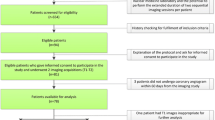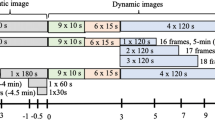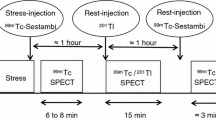Abstract
Background
A novel ultra-fast solid-state cardiac camera (Discovery NM 530c, General Electric) allows much shorter acquisition times compared to standard dual-detector SPECT cameras. This design enables investigation of the potential for early myocardial perfusion imaging (MPI) following a rest injection of technetium-99m (Tc-99m) rather than the conventional 45-60 minute delay in image acquisition.
Methods
A total of 30 patients underwent MPI at rest using Tc-99m sestamibi (n = 9) or tetrofosmin (n = 21). A 12 minute image acquisition in list mode was performed immediately following isotope injection. Patients also underwent a conventional delayed image acquisition 60 minutes following the rest isotope injection (image acquisition over 4 minutes). The immediate 12 minute acquisition was divided into three 4-minute intervals for image reconstruction (0-4, 4-8, and 8-12 minutes). The perfusion images were interpreted by two experienced physicians who evaluated each study for overall image quality (good, acceptable, or unacceptable) and graded each image using the summed rest score (SRS) and the standard 17-segment, 5-point scale model.
Results
The images acquired in the 0-8 minute time interval were predominantly uninterpretable due to excessive blood pool uptake. The images acquired in the 8-12 minute time interval were interpretable and compared to the conventional images obtained at 60 minutes. Overall image quality was better on the 60 minute image (17 good, 13 acceptable) compared with 8-12 minute image (3 good, 25 acceptable, 2 unacceptable). Sixteen of the 30 patients had an improvement in overall image quality by at least one category using the 60 minute delayed image. Nine of the 30 patients (2 Tc-99m sestamibi; 7 Tc-99m tetrofosmin) had at least one uninterpretable myocardial segment due to liver and/or bowel overlapping the myocardium on the 8-12 minute images vs 1 patient (1 myocardial segment) with this problem on the 60 minute delayed images (P = .005). Uninterpretable segments (total of 16) on the 8-12 minute images were confined to the apex and inferior wall. The mean SRS of the interpretable 8-12 minute images (n = 21) was 3.2 (95% confidence intervals; 1.0, 5.4) compared to 1.6 (95% confidence intervals; 0, 3.3) on the 60 minute delayed images in those patients (P = .005).
Conclusions
Overall image quality was better with fewer uninterpretable studies and a lower SRS on the rest images obtained at 60 minutes compared to early image acquisition (8-12 minutes following isotope injection). These findings do not support the routine use of early image acquisition with this new solid-state ultra-fast camera system.





Similar content being viewed by others
References
Bocher M, Blevis IM, Tsukerman L, Shrem Y, Kovalski G, Volokh L. A fast cardiac gamma camera with dynamic SPECT capabilities: Design, system validation and future potential. Eur J Nucl Med Mol Imaging 2010;37:1887-902.
Esteves F, Raggi P, Folks R, Keidar Z, Wells Askew J, Rispler S, et al. Novel solid-state-detector dedicated cardiac camera for fast myocardial perfusion imaging: Multicenter comparison with standard dual detector cameras. J Nucl Cardiol 2009;16:927-34.
Slomka P, Patton J, Berman D, Germano G. Advances in technical aspects of myocardial perfusion SPECT imaging. J Nucl Cardiol 2009;16:255-76.
Buechel RR, Herzog BA, Husmann L, Burger IA, Pazhenkottil AP, Treyer V, et al. Ultrafast nuclear myocardial perfusion imaging on a new gamma camera with semiconductor detector technique: First clinical validation. Eur J Nucl Med Mol Imaging 2010;37:773-8.
Herzog BA, Buechel RR, Katz R, Brueckner M, Husmann L, Burger IA, et al. Nuclear myocardial perfusion imaging with a cadmium–zinc–telluride detector technique: Optimized protocol for scan time reduction. J Nucl Med 2010;51:46-51.
Sharir T, Slomka PJ, Berman DS. Solid-state SPECT technology: Fast and furious. J Nucl Cardiol 2010;17:890-6.
Henzlova MJ, Cerqueira MD, Hansen CL, Taillefer R, Yao S-S. ASNC imaging guidelines for nuclear cardiology procedures: Stress protocols and tracers. 2009. Available at: http://www.asnc.org/section_73.cfm
Holly TA, Abbott BG, Al-Mallah M, Calnon DA, Cohen MC, DiFilippo FP, et al. Single photon-emission computed tomography. J Nucl Cardiol 2010;17:941-73.
Berman DS, Kang X, Tamarappoo B, Wolak A, Hayes SW, Nakazato R, et al. Stress thallium-201/rest technetium-99m sequential dual isotope high-speed myocardial perfusion imaging. J Am Coll Cardiol Imaging 2009;2:273-82.
Nakazato R, Tamarappoo BK, Kang X, Wolak A, Kite F, Hayes SW, et al. Quantitative upright-supine high-speed SPECT myocardial perfusion imaging for detection of coronary artery disease: Correlation with invasive coronary angiography. J Nucl Med 2010;51:1724-31.
Gimelli A, Bottai M, Giorgetti A, Genovesi D, Kusch A, Ripoli A, et al. Comparison between ultrafast and standard single-photon emission ct in patients with coronary artery disease/clinical perspective. Circulation 2011;4:51-8.
Duvall W, Croft L, Godiwala T, Ginsberg E, George T, Henzlova M. Reduced isotope dose with rapid SPECT MPI imaging: Initial experience with a CZT SPECT camera. J Nucl Cardiol 2010;17:1009-14.
Sharir T, Ben-Haim S, Merzon K, Prochorov V, Dickman D, Ben-Haim S, et al. High-speed myocardial perfusion imaging: Initial clinical comparison with conventional dual detector anger camera imaging. J Am Coll Cardiol Imaging 2008;1:156-63.
Sharir T, Slomka PJ, Hayes SW, DiCarli MF, Ziffer JA, Martin WH, et al. Multicenter trial of high-speed versus conventional single-photon emission computed tomography imaging: Quantitative results of myocardial perfusion and left ventricular function. J Am Coll Cardiol 2010;55:1965-74.
Acknowledgment
Drs Askew and O’Connor were investigators of a research grant funded by GE Healthcare to evaluate the Discovery NM 530c.
Author information
Authors and Affiliations
Corresponding author
Rights and permissions
About this article
Cite this article
Askew, J.W., Miller, T.D., Ruter, R.L. et al. Early image acquisition using a solid-state cardiac camera for fast myocardial perfusion imaging. J. Nucl. Cardiol. 18, 840–846 (2011). https://doi.org/10.1007/s12350-011-9423-7
Received:
Accepted:
Published:
Issue Date:
DOI: https://doi.org/10.1007/s12350-011-9423-7




